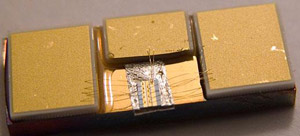- News
19 February 2014
Leeds University demos first THz laser chip with pulsed peak power exceeding 1W
The UK’s University of Leeds has fabricated what is claimed to be the world’s most powerful terahertz (THz) laser chip, exceeding 1 Watt output power from a quantum cascade laser (QCL) (Lianhe Li et al, ‘Terahertz quantum cascade lasers with >1W output powers’, Electronics Letters (2014) Vol 50, Issue 4, p309).
Terahertz waves (lying between infrared and microwave in the electromagnetic spectrum) can penetrate materials that block visible light and have a wide range of possible uses including chemical analysis, security scanning, medical imaging, and telecoms. Potential applications include monitoring pharmaceutical products, the remote sensing of chemical signatures of explosives in unopened envelopes, and the non-invasive detection of cancers in the human body. However, one of the main challenges is making the lasers powerful and compact enough to be useful.
“Although it is possible to build large instruments that generate powerful beams of terahertz radiation, these instruments are only useful for a limited set of applications,” says Edmund Linfield, professor of Terahertz Electronics at Leeds University’s School of Electronic and Electrical Engineering. “We need terahertz lasers that not only offer high power but are also portable and low cost.” The quantum cascade terahertz lasers being developed by Leeds are only a few square millimetres in size.
 Picture:
Leeds University’s THz laser chip.
Picture:
Leeds University’s THz laser chip.
Last October, Austria’s Vienna University of Technology reported an output power of 0.47 Watt from a single laser facet of a quantum cascade terahertz laser, nearly doubling the prior record of Massachusetts Institute of Technology (MIT).
Now, Leeds has fabricated broad-area high-power THz QCLs by growing an aluminum gallium arsenide-based (Al0.16Ga0.84As/GaAs) heterostructure on a semi-insulating GaAs substrate, then pholithographically creating 145-425μm-wide ridges. Cooled by liquid helium, the resultant lasers were operated at a temperature of 10K, and in pulsed mode (at 10kHz and a 2% duty cycle). A version with a 425μm-wide ridge and a 3mm-long cavity gave a peak power output of 780mW. However, by applying a high-reflectivity coating to the rear facet of a 4.2mm-long cavity, the single-facet peak power output (at an emission frequency of 3.4THz) was boosted to a record 1.01 Watts, more than doubling the landmark set by Vienna University of Technology. For the 3mm-long cavity, even at a higher operating temperature of 77K, the peak power output was still 420mW. The maximum operating temperature is 123K.
“The record power of our new laser is due to the expertise that we have developed at Leeds in fabricating these layered semiconductors, together with our ability to engineer these materials subsequently into suitable and powerful laser devices,” says Linfield.
“The University of Leeds has been an international leader in terahertz engineering for many years,” comments Giles Davies, professor of Electronic and Photonic Engineering. “This work is a key step toward increasing the power of these lasers while keeping them compact and affordable enough to deliver the range of applications promised by terahertz technology.”
The researchers note that an increase in the power output should be expected if the QCL design is scaled to higher emission frequencies.
The work of the Leeds team was funded mainly by the UK’s Engineering and Physical Sciences Research Council (EPSRC).
Harvard–Leeds team boost THz laser collimation and power collection efficiency
Leeds wins €2.5m European grant to research terahertz optoelectronics
Accessing higher THz gain with switched quantum cascade lasers
THz QCL operating temperature raised by 10°C
http://digital-library.theiet.org/content/journals/10.1049/el.2013.4035


